Photo
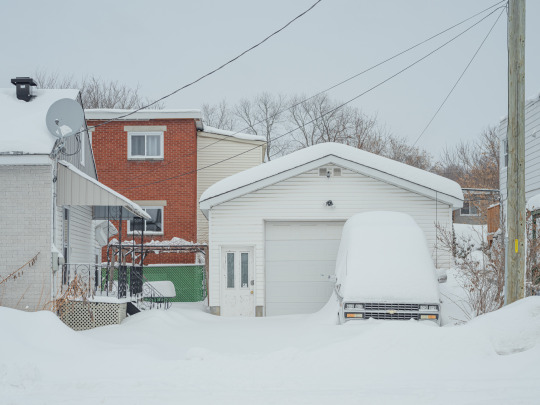

After snowstorm
Vanier, Ottawa
January 2023
© Blazej Marczak / www.bmarczak.com
#landscape#photography#urban#winter#documentary#fotografia#city#ottawa#canada#krajobraz#art#kanada#Architecture#snow#vanier
26 notes
·
View notes
Text
Vibrancy of autumn morphs into pale and lethargic stoicism of winter. As summer yielded to fall, autumn would yield to the colder months. Constant flux. There is somehow a *turpist quality in the fall vistas.
"Urban nature illuminated by artificial light; Rideau River Nature Trail"
October 2022
Ottawa, Canada
© Błażej Marczak / www.bmarczak.com
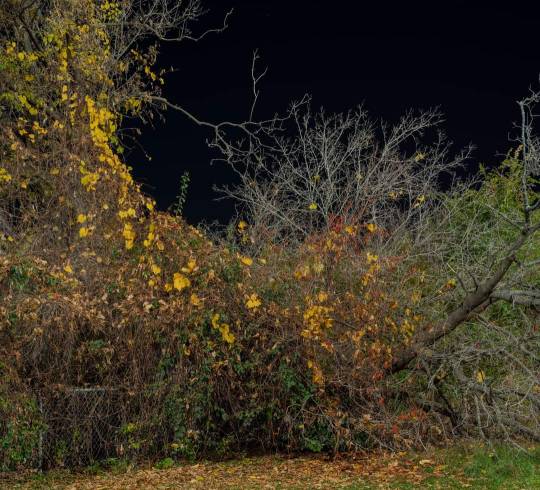
#photography#documentary#landscape#urban#city#canada#ottawa#miasto#kanada#nature#night photography#artificial condition
18 notes
·
View notes
Photo
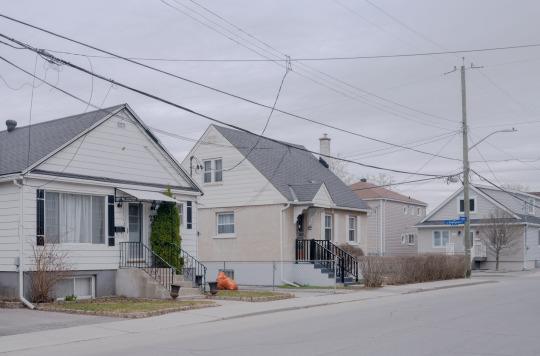
One of these many quiet days during the lockdown when greys of early spring exposed the beauty of the sporadic colour.
Granville StVanier, Ottawa
08.04.2020
© Blazej Marczak / www.bmarczak.com
10 notes
·
View notes
Text



On the importance of revisiting old inspirations.
“Corner House; Rue Marier and Rue Montfort”
The Vanier neighbourhood in which the photographed location is situated was the very first area of Ottawa which I had a chance to explore upon my arrival from Scotland in 2016. The corner house located at the intersection of Marier and Montfort Street caught my attention long before I started working on “Ottawa” series. Despite being a part of what I perceive as urban landscape characteristic for the region, this corner always reminded me of more distant places, namely small towns in France and Poland.
I observed the hydro poles, network of overhead wires, rows of gabled roofed houses with porches and clad with siding; yet, despite all of these distinguishingly North American features I also saw resemblance to some places I know from Europe. ( I also experienced the feeling of “familiarity”- keep reading to find why)
Vanier and Ottawa as a whole are areas in transition. The character of the neighbourhood is gradually changing and so is its appearance. For varying reasons we might be unable or unwilling to preserve the physical characteristics of the area. Aspects which connect the present with the past could be easily erased from the urban landscape. Visual records such as photographs can be used to help us maintain the memory of it. There are numerous reasons for preserving the memories. Sometimes preservation of the memory is the only available option.
I wrote the note above in June 2021.
Yesterday while browsing excellent publication “Walker Evans: The magazine work” by David Campany I came across one of my favourite photographs. It is a photograph by Eugène Atget called “Coin Rue de Seine”
I love this image not only for its visual qualities. This image reminds me why I am preoccupied with particular type of photographic style and subject matter. Images by Atget and images of photographers who drew from his work keep inspiring me and giving me the impulse to go outside and photograph the ever changing city.
It is easy to forget the role of subconsciousness in the creative process. I didn’t think about Atget image when I was photographing “Corner House; Rue Marier and Rue Montfort” and yet my memory of it was present in my mind and being mixed with my own experiences resulted in creating the image you can see here. This brings me to the conclusion that the things we look at and things we surround ourselves with have a bigger influence on us than we sometimes realize when we are preoccupied with our creative pursuits. It is important to me to switch off the screen, grab a book and look beyond the easy to consume and forget imaginary which like never before pollutes our visual environment. It is beneficial to me to pause and go back to the works of art which inspired me many years ago and look at them with a new understanding. However outdated some things might seem they might at some point in the future stimulate our senses to create something new. This in turn brings me to think about the importance of recording the traces of material culture (heritage if you like) which are so easily swept aside by the forces beyond our control. There is wealth of ideas behind every man made object. Photography is one of the means thanks to which we can remind ourselves about the old concepts and decide if we want to ignore or draw upon them.
Photo of the book: © Steidl
Read more about Atget photograph here
#photography#landscape#history#art#city#urban#canada#poland#france#atget#walker evans#miasto#inspiration#subconscious#creative process#heritage#getty
5 notes
·
View notes
Photo

Riverside Drive
10th of November 2022
From "Ottawa" series
© Błażej Paweł Marczak / www.bmarczak.com
#photography#urban#documentary#ottawa#canada#november#2022#kanada#city#car#beton#concrete#infrastructure#miasto#fotografi
6 notes
·
View notes
Photo

I am very happy to show “Queuing” during the “Holding Pattern: 2021 Additions” exhibition which showcases work recently purchased by the City of Ottawa and added to the City of Ottawa Art Collection.
Photograph on display is a part of a limited edition print run consisting of 20 prints available for purchase from yours truly.
You will only see a short bio and general info about my work during the exhibition so I Am posting a more comprehensive text about this particular image below
I hope you will find time to see my print and other artwork from local artists in person at the City Hall Art Gallery. The exhibition runs from December 17th, 2021 to February 11th, 2022. Info: https://bit.ly/3pSf18X
Statement:
Covid-19 changed our society. I was interested in capturing some aspects of this rapid transformation of our lives. During the more conventional circumstances I am inquisitive about the commonplace rather than the extraordinary. However, the pandemic and our response to it made the abnormal the new commonplace. I ought to create a visual documentation of the behaviors which were unfamiliar to us before the pandemic but quickly became part of our everyday routine.
I treasure the peculiar relationship of photography with reality and its ability to transform what’s in front of the camera into a symbolic object which can allow us to pause and contemplate the real world. Unembellished images of the prosaic scenes have a potential to be more than straightforward records of the perceivable.
My aim was to document and highlight how the state of our seemingly “solid” reality can morph into something less comprehensible. Transient, fluid nature of the modern world is considered by the sociologist Zygmunt Bauman who coined the term “Liquid Modernity” and profoundly influenced my way of seeing.
“What has been cut apart cannot be glued back together. Abandon all hope of totality, future as well as past, you who enter the world of fluid modernity.”― Zygmunt Bauman; “Liquid Modernity”
“Queuing”
From the “Pandemic Vistas” chapter of the “Ottawa” series.
Beechwood Ave, Vanier, Ottawa
08.04.2020
© Blazej Marczak / www.bmarczak.com
#photography#documentary#pandemic#covid#ottawa#landscape#canada#art#exhibition#ontario#photographic art#urban landscape#urban#city#contemporary#queuing#social dystancing#dystancing#physical distancing#covid-19#corona virus#society#zygmunt bauman#modernity#liquid modernity#sociology#bauman
29 notes
·
View notes
Photo

Parking lot; Greensway Ave
Ottawa
24.04.2020
© Blazej Marczak / www.bmarczak.com
#ottawa#canada#kanada#grey#Everyday#urban landscape#photography#trees#Architecture#city#autumn#cold#gray#bleak#depressing
21 notes
·
View notes
Photo

Ste-Anne Ave
Vanier, Ottawa
08.04.2020
© Blazej Marczak / www.bmarczak.com
20 notes
·
View notes
Photo

Behind Eastview Shopping Centre
Montgomery St, Vanier, Ottawa
24.04.2020
© Blazej Marczak / www.bmarczak.com
#architecture#concrete#covid#modernism#modernist#city#urban landscape#landscape#documentary#photography
13 notes
·
View notes
Photo

Hull, QC seen from Ottawa, ON
21.11.2020
© Blazej Marczak / www.bmarczak.com
#architecture#modernism#ottawa#river#hull#quebec#canada#autumn#brutalism#concrete#urban#urban landscape#photography
214 notes
·
View notes
Photo

F$EARS
31.10.2020
St. Laurent Centre, Ottawa, Canada
© Blazej Marczak / www.bmarczak.com
#Ottawa#Canada#Photography#landscape#city#urban#sears#retail#futurism#modernism#architecture#concrete#future#commercial#commerciallandscape
24 notes
·
View notes
Photo

One of my rules is to create a photograph that will depict the scene I saw with my own eyes as accurately as possible.
The high concentration of iron in these rocks gives them a reddish colour and I love how they correspond to the amazing autumn colours of the surrounding vegetation. There is also plenty of lime in these rocks which enable this ecosystem to neutralise the acid from the devastating acid rains.
A lichen called Xanthoria also benefits from the high concentration of lime/calcium carbonate and is visible here as a yellowish patches on the rocks.
Can you spot a man on the kayak?
Sec Lake
Algonquin Park, Ontario
26.09.2020
Composite from 14 separate exposures
© Blazej Marczak / www.bmarczak.com
#landscape#photography#canada#kanada#ontario#travel#outdoor#water#lake#lac#algonquin#park#nature#Wanderlust#autumn#fall
7 notes
·
View notes
Photo

View from the edge of Barron Canyon situated in the Algonquin Provincial Park, Ontario.This breathtaking landscape is a result of many geological processes among which erosion is the most recent and one which shaped the canyon into its present form.
Erosion started at the end of the last Ice Age, about 11,00 years ago when the region “been exposed by the northward retreat of the melting Laurentide Ice Sheet which had covered almost all of Canada and parts of the northern U.S.A.”*
Water from the prehistoric Algonquin Lake, one of the lakes created by the melting glacier, was carried through the fault (break) in the earth’s crust at thundering speeds causing the widening and deepening of the fault.The fault itself thought is a result of geological events that occurred over millions of years before the retread of the glacier.
Exposed rocks of the canyon are part of the Canadian Shield which is a revealed portion of the North American craton, a stable part of the earth’s crust that holds continents together while floating on magma or the liquid rock deep beneath the surface of the earth.
The canyon is slowly but constantly expanding as the walls of the canyon are being constantly eroded. Subzero temperatures contribute to the cracking of the rocks which shattered debris accumulate on so-called talus slopes which are visible on both of the images.
Barron Canyon, Algonquin Provincial Park
Ontario, Canada
27.09.2020
© Blazej Marczak / www.bmarczak.com
*From Barron Canyon Trail guide published by The Friends of Algonquin Park http://store.algonquinpark.on.ca/.../algonquin.../00109.html
6 notes
·
View notes
Photo

View from the edge of Barron Canyon situated in the Algonquin Provincial Park, Ontario.This breathtaking landscape is a result of many geological processes among which erosion is the most recent and one which shaped the canyon into its present form.
Erosion started at the end of the last Ice Age, about 11,00 years ago when the region “been exposed by the northward retreat of the melting Laurentide Ice Sheet which had covered almost all of Canada and parts of the northern U.S.A.”*
Water from the prehistoric Algonquin Lake, one of the lakes created by the melting glacier, was carried through the fault (break) in the earth’s crust at thundering speeds causing the widening and deepening of the fault.The fault itself thought is a result of geological events that occurred over millions of years before the retread of the glacier.
Exposed rocks of the canyon are part of the Canadian Shield which is a revealed portion of the North American craton, a stable part of the earth’s crust that holds continents together while floating on magma or the liquid rock deep beneath the surface of the earth.
The canyon is slowly but constantly expanding as the walls of the canyon are being constantly eroded. Subzero temperatures contribute to the cracking of the rocks which shattered debris accumulate on so-called talus slopes which are visible on both of the images.
Barron Canyon, Algonquin Provincial Park
Ontario, Canada
27.09.2020
© Blazej Marczak / www.bmarczak.com
*From Barron Canyon Trail guide published by The Friends of Algonquin Park http://store.algonquinpark.on.ca/.../algonquin.../00109.html
#landscape#canada#ontario#nature#rocks#documentary#river#park#kanada#travel#outdoor#photography#north america#history#geology#barron canyon#canyon#algonquin#canadian#craton#lake#glacier#ice age#earth
4 notes
·
View notes
Photo

You know me mostly for my urban landscapes but you don't expect me to turn a blind eye on such beautiful surroundings right? Prints of this image are available per request and 10% of the profit will be donated to organisation working towards water preservation.
Canadian landscape although significantly altered by human activity especially since the arrival of European settlers is still breathtaking. There are over 250,000 lakes in Ontario the province in which I live. These lakes account for around 20% of the world's freshwater supply.We tend to take water for granted but the water supply is not endless.
UN study predicts that water would be in such high demand by 2030 that the global water resources would be enough just for the 60% of the global demand....that's 7 billion people affected by the lack of drinking water.
Someone smart said once that the wars of the future will be fought over water, not oil...
There are many threads to the water and no one simple solution but one of the ways to preserve our precious resources is to stop buying bottled water and push for banning the unnecessary use and production of such.
Nestle is the largest food corporation in the world and one of the worst water abusers across the globe. Nestle is pumping out water from wells in rural Ontario on an unprecedented scale. This practice damages the local watersheds as the bottled water after being shipped across the globe can't reenter regional water systems as it naturally does.
By not buying Nestle products we can all send them a message that: WATER IS A HUMAN RIGHT, NOT A COMMODITY.
Sec Lake
Algonquin Park, Ontario
26.09.2020
Composite image from eight separate exposures.
© Blazej Marczak / www.bmarczak.com
Resources: http://www.saveourwater.ca/
https://bit.ly/2EFArCK
https://bit.ly/3n0WJQE
https://canadians.org/nestle
#landscape#photography#water#canada#ontario#algonquin#woda#human rights#watershed#nature#trees#forest#lake#lac#rural#wild#natural#climate change#nestle#un#kanada
9 notes
·
View notes
Photo

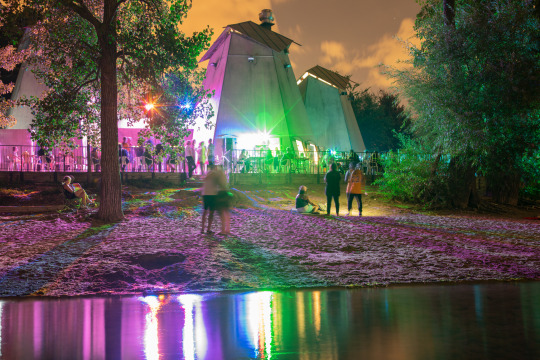
Fiesta Cubana party hosted on the patio of iconic modernist Westboro Beach Pavilions designed by Ottawa's architect James Strutt in 1966. The activities along of Ottawa River weren't always so laid back thought.
For thousands of years, it was an important trading route and spiritual place for the Anishinabeg (Algonquin people) who call this river Kichi Sibi (Great River) The current (pun intended) name "Ottawa River" is derived from the Anishinàbemowin (Algonquin language) word adàwe, meaning “to trade”.
In "The Waterways" series which itself is part of the larger body of work "Ottawa" I document how natural and man-made waterways are being used within the boundaries of the Canadian capital city. While working in the landscape tradition I also aim to record the daily or in this case the nightly activities and local architecture to name just a couple of subjects I am interested in. I Am following the rivers, canals, and creeks in search of the overlooked and the well-known. This series started as a pretext to get out there and learn about my new home town. As there won't be Ottawa without Ottawa River and other smaller bodies of water I thought that focusing on them would be more than appropriate.
Westboro Beach
Ottawa
15.09/2018
© Blazej Marczak / www.bmarczak.com/ottawa
#ottawa#canada#landscape#photography#documentary#urban#river#water#north america#modernist#architecture#night#party#concrete#ottawa river#history#first nations
3 notes
·
View notes
Photo
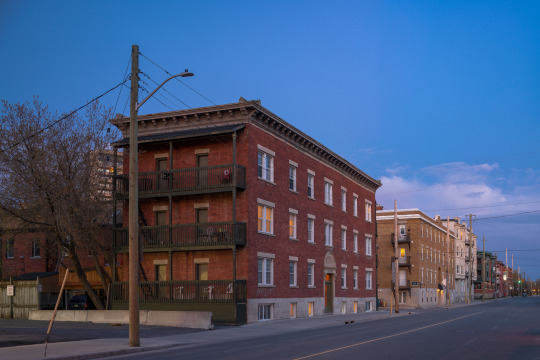
I love to photograph places that can trigger my imagination and despite being unique to themselves can also transport me metaphysically in time and space to imaginary worlds. These dreamlike worlds are made from my preconceptions, bits, and pieces glued together in my mind from the information gathered by reading and looking at historic and contemporary images of the real cities and regions I didn't have a chance to see yet. I never visited a prairie city, let alone a prairie city from a century ago but I felt like I am in one that day when I walked through Charlotte Street for the first time four years ago just after my arrival in Canada. This street often feels somehow different to me, especially on quiet sunny Sundays or during harsh winter days when not many people are wandering outside and when students who are occupying most of the apartments in the area leave for home. The hazy, dreamy but not uninviting mood is often there (or rather in my head when I am there) and I have no idea if I would feel similarly when walking through let’s say...Regina the prairie city after which one of the buildings on Charlotte Street was named for. Perhaps there is some truth to "Canada in one city" the official slogan of Ottawa?
Charlotte St
Sandy Hill, Ottawa
07.05.2020
© Blazej Marczak / www.bmarczak.com
#photography#canada#ottawa#architecture#regina#dusk#blue hour#landscape#city#urban#kanada#travel#documentary#empty#desolate#quiet#canadian
4 notes
·
View notes